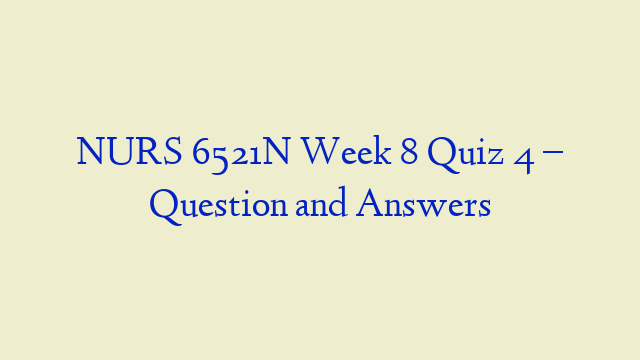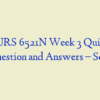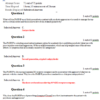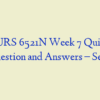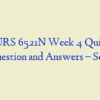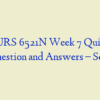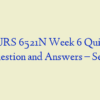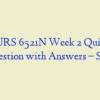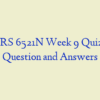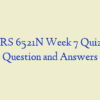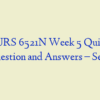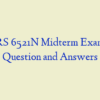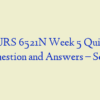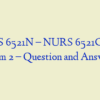Description
NURS 6521 Week 8 Quiz – Question and Answers
- An immunocompromised patient with a diagnosis of candidiasis has failed to respond to conservative therapy and has consequently begun treatment with amphotericin B. The nurse is aware that this drug achieves a therapeutic effect by way of its influence on
- A nurse is caring for a patient who is on amphotericin B. On morning rounds the patient reports weakness, numbness, and a tingling sensation in his feet. What would be a priority action by the nurse?
- A patient has been prescribed daptomycin for a complicated skin infection. Which of the following will the nurse advise the patient to report immediately?
- A 30-year-old African-American woman tested positive for TB and is prescribed isoniazid. The nurse will plan the patient’s care to include close monitoring of the drug therapy because
- A 7-year-old child has tonsillitis and is prescribed penicillin V, which is to be administered at home. The nurse will instruct the parents to administer the drug
- A patient has endocarditis and is taking gentamicin. The nurse will be sure to monitor which of the following?
- A 49-year-old farmer who normally enjoys good health has become seriously ill in recent days and the results of an extensive diagnostic work up have resulted in a diagnosis of histoplasmosis. The patient has been admitted to the hospital and has begun treatment with amphotericin B. The nurse who is providing care for the patient should prioritize which of the following diagnostic results during his course of treatment?
- A patient is prescribed ganciclovir to treat a CMV infection. An oral dosage is prescribed. To help increase bioavailability of the drug, the nurse will encourage the patient to take the medication
- Which of the following nursing actions is most important in achieving successful antimicrobial therapy with vancomycin?
- A child is taking permethrin for head lice. The nurse will instruct her mother to
- A patient is taking rifampin (Rifadin) for active TB. When discussing this drug with the patient, the nurse should stress that
- A nurse is providing education to a patient who is taking INH. The nurse will advise the patient to avoid which of the following foods?
- A 15-year-old patient has meningitis caused by Haemophilus influenzae. She is being treated with chloramphenicol. The most important nursing action for this patient would be to monitor
- A patient has been admitted to the critical care unit of the hospital with bacterial septicemia that has failed to respond to initial antibiotic treatment. The patient’s most recent blood cultures reveal the presence of methicillin-resistant Staphylococcus aureus (MRSA) in the patient’s blood. The nurse will anticipate that this patient will likely require intravenous administration of what antibiotic?
- A patient is receiving cefazolin in combination with anticoagulants. To minimize the adverse effects during therapy, the nurse will
- A 20-year-old female patient is receiving topical clindamycin for acne vulgaris. She develops a rash and urticaria along with severe itching where the medication is applied. The nurse will formulate which of the following nursing diagnoses for the patient?
- A nurse is instructing a colleague on how an antimicrobial produces a therapeutic effect. Which of the following should be included in the nurse’s teaching?
- A patient has been admitted to the critical care unit with a diagnosis of peritonitis that has necessitated treatment with gentamicin. As a result, the care team should be cautious when concurrently administering other medications that may cause
- A 45-year-old female patient is prescribed ciprofloxacin to treat a bronchial infection. A nursing assessment revealed that she started taking daily vitamin supplements about 2 years ago. To maximize the therapeutic effects of the ciprofloxacin therapy, the nurse should advise the patient to
- A nurse is explaining the use of acyclovir therapy to a 72-year-old man. Nephrotoxicity is discussed as a major adverse effect in older patients. To minimize the risk of the patient developing this adverse effect, the nurse will advise him to
- A 43-year-old man has been diagnosed with active TB. He is prescribed a multiple drug therapy, including INH and rifampin. A priority assessment by the nurse will be to monitor which combination of laboratory test results?
- A 72-year-old patient is prescribed ophthalmic ciprofloxacin for a bacterial infection in her right eye. The nurse will teach her to observe for which of the following adverse effects of the drug?
- An immunocompromised patient in a critical care setting has developed a respiratory infection that has been attributed to methicillin-resistantStaphylococcus aureus (MRSA). The nurse should anticipate that the patient will require treatment with
- A patient is receiving long-term clindamycin therapy for a life-threatening infection. The nurse will begin by monitoring this drug therapy by obtaining
- Which of the following would a nurse assess for in a patient who is taking polymyxin B systemically?
- Which of the following is critical to helping prevent development of resistant strains of microbes in patients?
- A 15-year-old boy is being carefully monitored for a skin infection and is being given ciprofloxacin. The nurse will observe for which of the following?
- Sulconazole has been prescribed for a patient with tinea pedis. The nurse will instruct the patient to use the topical agent
- A patient is being treated for Mycoplasma pneumoniae pneumonia. She is allergic to penicillin and is being given azithromycin (Zithromax) in capsule form. The nurse will inform the patient that she will need to take the capsule
- A 9-year-old boy was bought to his primary care provider by his mother with signs and symptoms of hookworm infection and will be sent home with a prescription for mebendazole. When provided patient and family education, the nurse should teach the mother with which of the following measures to avoid reinfection following treatment?
- A 30-year-old woman who is in the first trimester of pregnancy has presented to her primary care provider with a 4-day history of a reddened, itchy left eye that is crusted with purulent exudate. The clinician suspects a bacterial, rather than viral, etiology. How will the patient’s pregnancy affect the potential use of ciprofloxacin to treat her conjunctivitis?
- Mr. Laird is a 49-year-old electrician who experienced severe burns on his trunk, arms, and hands in a workplace accident 2 weeks ago. Part of his current wound care regimen involves the daily application of silver sulfadiazine to his wounds. The nurses who are providing care for Mr. Laird in the burns and plastics unit of the hospital should perform what action when administering this medication?
- A 34-year-old male has been diagnosed with TB and will be started on INH therapy. The medication history reveals that he currently takes antacids on a regular basis. The nurse will instruct the patient to take
- A nurse has questioned why a patient’s physician has prescribed a narrow-spectrum antibiotic rather than a broad-spectrum drug in the treatment of a patient’s infection. Which of the following facts provides the best rationale for the use of narrow-spectrum antibiotics whenever possible?
- A patient is to begin taking tobramycin (Nebcin) for a nosocomial infection. Which of the following assessments should the nurse prioritize?
NURS 6521 Week 8 Quiz
- An immunocompromised patient with a diagnosis of candidiasis has failed to respond to conservative therapy and has consequently begun treatment with amphotericin B. The nurse is aware that this drug achieves a therapeutic effect by way of its influence on
- A nurse is caring for a patient who is on amphotericin B. On morning rounds the patient reports weakness, numbness, and a tingling sensation in his feet. What would be a priority action by the nurse?
- A patient has been prescribed daptomycin for a complicated skin infection. Which of the following will the nurse advise the patient to report immediately?
- A 30-year-old African-American woman tested positive for TB and is prescribed isoniazid. The nurse will plan the patient’s care to include close monitoring of the drug therapy because
- A 7-year-old child has tonsillitis and is prescribed penicillin V, which is to be administered at home. The nurse will instruct the parents to administer the drug
- A patient has endocarditis and is taking gentamicin. The nurse will be sure to monitor which of the following?
- A 49-year-old farmer who normally enjoys good health has become seriously ill in recent days and the results of an extensive diagnostic work up have resulted in a diagnosis of histoplasmosis. The patient has been admitted to the hospital and has begun treatment with amphotericin B. The nurse who is providing care for the patient should prioritize which of the following diagnostic results during his course of treatment?
- A patient is prescribed ganciclovir to treat a CMV infection. An oral dosage is prescribed. To help increase bioavailability of the drug, the nurse will encourage the patient to take the medication
- Which of the following nursing actions is most important in achieving successful antimicrobial therapy with vancomycin?
- A child is taking permethrin for head lice. The nurse will instruct her mother to
- A patient is taking rifampin (Rifadin) for active TB. When discussing this drug with the patient, the nurse should stress that
- A nurse is providing education to a patient who is taking INH. The nurse will advise the patient to avoid which of the following foods?
- A 15-year-old patient has meningitis caused by Haemophilus influenzae. She is being treated with chloramphenicol. The most important nursing action for this patient would be to monitor
- A patient has been admitted to the critical care unit of the hospital with bacterial septicemia that has failed to respond to initial antibiotic treatment. The patient’s most recent blood cultures reveal the presence of methicillin-resistant Staphylococcus aureus (MRSA) in the patient’s blood. The nurse will anticipate that this patient will likely require intravenous administration of what antibiotic?
- A patient is receiving cefazolin in combination with anticoagulants. To minimize the adverse effects during therapy, the nurse will
- A 20-year-old female patient is receiving topical clindamycin for acne vulgaris. She develops a rash and urticaria along with severe itching where the medication is applied. The nurse will formulate which of the following nursing diagnoses for the patient? 17. A nurse is instructing a colleague on how an antimicrobial produces a therapeutic effect. Which of the following should be included in the nurse’s teaching?
- A patient has been admitted to the critical care unit with a diagnosis of peritonitis that has necessitated treatment with gentamicin. As a result, the care team should be cautious when concurrently administering other medications that may cause
- A 45-year-old female patient is prescribed ciprofloxacin to treat a bronchial infection. A nursing assessment revealed that she started taking daily vitamin supplements about 2 years ago. To maximize the therapeutic effects of the ciprofloxacin therapy, the nurse should advise the patient to
- A nurse is explaining the use of acyclovir therapy to a 72-year-old man. Nephrotoxicity is discussed as a major adverse effect in older patients. To minimize the risk of the patient developing this adverse effect, the nurse will advise him to
- A 43-year-old man has been diagnosed with active TB. He is prescribed a multiple drug therapy, including INH and rifampin. A priority assessment by the nurse will be to monitor which combination of laboratory test results?
- A 72-year-old patient is prescribed ophthalmic ciprofloxacin for a bacterial infection in her right eye. The nurse will teach her to observe for which of the following adverse effects of the drug?
- An immunocompromised patient in a critical care setting has developed a respiratory infection that has been attributed to methicillin-resistant Staphylococcus aureus (MRSA). The nurse should anticipate that the patient will require treatment with
- A patient is receiving long-term clindamycin therapy for a life-threatening infection. The nurse will begin by monitoring this drug therapy by obtaining
- Which of the following would a nurse assess for in a patient who is taking polymyxin B systemically?
- Which of the following is critical to helping prevent development of resistant strains of microbes in patients?
- A 15-year-old boy is being carefully monitored for a skin infection and is being given ciprofloxacin. The nurse will observe for which of the following?
- Sulconazole has been prescribed for a patient with tinea pedis. The nurse will instruct the patient to use the topical agent
- A patient is being treated for Mycoplasma pneumoniae pneumonia. She is allergic to penicillin and is being given azithromycin (Zithromax) in capsule form. The nurse will inform the patient that she will need to take the capsule
- A 9-year-old boy was bought to his primary care provider by his mother with signs and symptoms of hookworm infection and will be sent home with a prescription for mebendazole. When provided patient and family education, the nurse should teach the mother with which of the following measures to avoid reinfection following treatment?
- A 30-year-old woman who is in the first trimester of pregnancy has presented to her primary care provider with a 4-day history of a reddened, itchy left eye that is crusted with purulent exudate. The clinician suspects a bacterial, rather than viral, etiology. How will the patient’s pregnancy affect the potential use of ciprofloxacin to treat her conjunctivitis?
- Mr. Laird is a 49-year-old electrician who experienced severe burns on his trunk, arms, and hands in a workplace accident 2 weeks ago. Part of his current wound care regimen involves the daily application of silver sulfadiazine to his wounds. The nurses who are providing care for Mr. Laird in the burns and plastics unit of the hospital should perform what action when administering this medication?
- A 34-year-old male has been diagnosed with TB and will be started on INH therapy. The medication history reveals that he currently takes antacids on a regular basis. The nurse will instruct the patient to take
- A nurse has questioned why a patient’s physician has prescribed a narrow-spectrum antibiotic rather than a broad-spectrum drug in the treatment of a patient’s infection. Which of the following facts provides the best rationale for the use of narrow-spectrum antibiotics whenever possible?
- A patient is to begin taking tobramycin (Nebcin) for a nosocomial infection. Which of the following assessments should the nurse prioritize?
